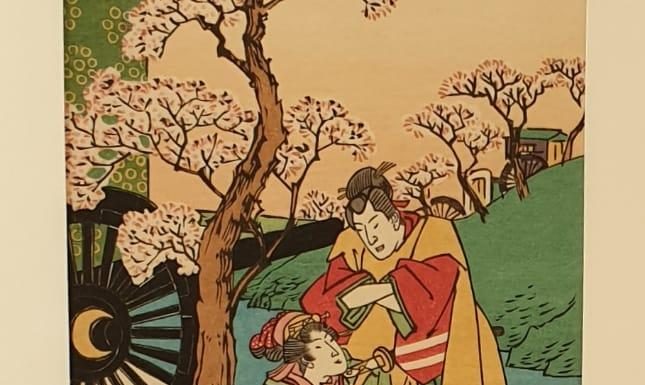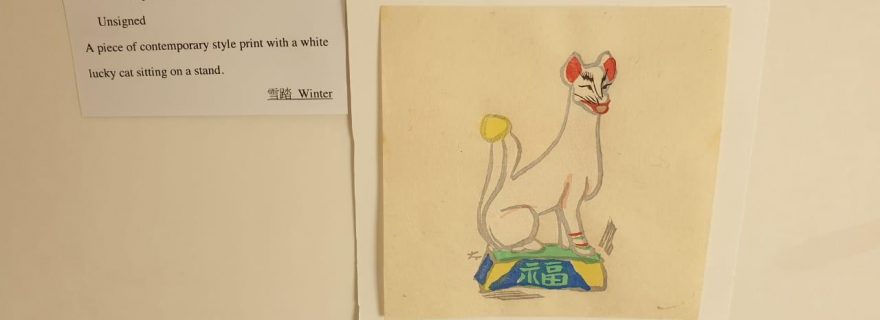Tales of the Beings: Possibly the smallest exhibition ever!
What do you do when you have already visited all the big museums in your neighborhood and still want to go and explore? You go to possibly the smallest exhibition ever to exist. It was located in a student apartment in The Hague and was curated by two students from Leiden University.
Two students and co-curators, Hannah Li (first year student of Arts, Media and Society) and Misha Zhou (BA Archaeology and MA International Relations), put their heads together to create a mini exhibition called Tales of the Beings. They collected beautiful prints, mostly purchased from private collectors, and transformed one of their apartments into a gallery space. The small gallery space consisted of two separate sections. One section displayed prints in chronological order, the other section strived for a thematic order – there were even erotic prints included but I will leave that one to the reader' imagination.

When walking into the gallery space, visitors see the prints displayed on the walls on the left-hand side. The first space was for the seasons and contained prints by Japanese artists, the majority of which were made between 1700 and 1800. Accompanying every print was a short description of when it was made and by whom, sometimes also with information about the content of the prints or short stories related to them. Most prints showed traditional Japanese scenes which often included traditional Japanese clothing, cats, and cherry blossoms.

As my eyes scanned through the room and took in the prints, it was noticeable how rich the colours of the prints were. Some colours were visible in several of the artworks, such as red, pink, and white. The depicted figures were also portrayed in a very particular way. They had very white faces and were tall, usually dressed in traditional Japanese clothes, most distinctly the Kimono. The images portrayed humans as well as animals. The cat is a common subject, either presented with other figures, or on its own. Cats are frequently depicted in Japanese art, as they are believed to bring good luck.

The cat is not the only subject of symbolic nature in Japanese prints. Cherry blossoms are symbolic for Spring as they bring a time of renewal. They were included in many of the prints in the Spring section. A spark of hope can be gleaned in the bright colours and the smiling people. Delighted the winter is behind them and ready to welcome better times. Something we could all use nowadays.
In the next section were prints depicting pleasure and beauty. More accurately, ‘pleasure’ in the sense of the Japanese term ‘ukiyo’, which means ‘the floating world’. The term describes the way of seeking pleasure as a lifestyle. Prints of events and theatre performances were portrayed. Beauty was mostly shown in the form of fair looking women wearing colourful and sometimes revealing clothes. It made me wonder about Western representations of gender and beauty, especially feminine beauty, since there seem to be familiar themes.

Overall, the exhibition was skillfully presented, categorizing the prints according to themes which created an easy order to follow. Although it was a small space the exhibition opened a world of wonders that was closed before, at least to this visitor. The size of the exhibition space may suggest that it was not very COVID19 friendly but there were only maximum of five people allowed in the space at any given time, making it easy to observe the 1,5-meter distance. The number of visitors was controlled through reservation of a time slot and it was mandatory to wear a mask during the visit. On top of that, the windows and the front door were kept open which made sure to keep the room ventilated.
The last day of the exhibition was 29th October but a digital catalogue will soon be published on the website https://liberatica.art/., making it possible to view for those who did not get a chance to visit in person.
About author: Unnur Hlíf Rúnarsdóttir is a first-year bachelor student of Arts, Media and Society. She is mainly interested in how art reflects on society, especially through film. Her favorite film is ‘A Clockwork Orange’ by Stanley Kubrick and every David Lynch movie she has seen so far. She aspires to become a film journalist in the future.


0 Comments